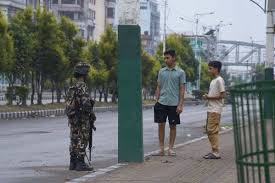
NEW YORK — “Happy Gilmore” was born on the range. When Adam Sandler was a kid growing up in New Hampshire, his father was an avid golfer. He’d often take his son along to hit balls at the driving range. But Sandler was uninterested in the sport, and usually got antsy.
“Why don’t you bring a friend?” his dad told him. So Sandler took his buddy, Kyle McDonough, a star hockey player who’d later turn professional.
“He never played before but he was cracking the ball so far,” Sandler recalls. “So when I started becoming a comedian and me and (Tim) Herlihy were writing stuff and stand-up and talking about movies, I started thinking about a guy who could hit it really big and had a hockey player mentality.”
“Happy Gilmore,” released in 1996, was Sander and Herlihy’s second movie, following “Billy Madison.” Sandler was just exiting “Saturday Night Live.” Herlihy was Sandler’s roommate at New York University and became a lawyer before Sandler got him to stick to writing comedy. (You might remember the “Herlihy Boy” sketch.) “We had just done our first movie, ‘Billy Madison,’ and we put every idea we ever had for a movie in that movie,” says Herlihy. “So when they said we could do another movie, it was like, ‘What are we going to do this movie about?’”
“Happy Gilmore,” released in February 1996, became one of the most beloved comedies of the ’90s and codified the hockey-style swing as a mainstay on golf courses. “A hop, skip and a hit,” as Sandler says. The movie also made comic heroes of Bob Barker, Christopher McDonald and Carl Weathers, and made lines like “Are you too good for your home?” plausible things to ask golf balls.
Like most cult comedies, “Happy Gilmore” didn’t start out an obvious instant classic, though. “A one-joke ‘Caddyshack’ for the blitzed and jaded,” wrote EW. “To describe Happy’s antics as boorish is putting it mildly,” wrote The New York Times. “‘Happy Gilmore’ tells the story of a violent sociopath,” wrote Roger Ebert. He called it “the latest in the dumber and dumbest sweepstakes.”
“Happy Gilmore” was a box-office success, grossing $39 million in the U.S. and Canada. And through worn-out DVDs and regular TV reruns, it became a favorite to generations of golfers and a staple of goofy ’90s comedy.
“I can’t even tell you how many times I’ve seen that movie,” says the actor-filmmaker Benny Safdie, who co-directed Sandler in “Uncut Gems.” “It was on an endless loop. I had the DVD and I just kept watching it. I can close my eyes and see the movie end to end. It’s one of my favorite movies.”
Now, nearly three decades later, and after years of batting away pleas for a sequel, Sandler has finally put Happy’s Bruins jersey back on. “Happy Gilmore 2,” which Netflix will debut Friday, is arguably the most anticipated streaming release of the summer.
Avoiding a comedy sequel curse
Sandler was well aware of the checkered history of comedy sequels. Movies like “Zoolander 2” and “Anchorman 2” have struggled to recapture the freewheeling spirit of the originals. The movie Sandler counts as his favorite, “Caddyshack” — so much so that he was initially hesitant to make a golf comedy — spawned 1988’s woebegone “Caddyshack II.”
“If someone brought it up to us, we were like, ‘Yeah, no, we’re not going to do that,’” Sandler said in a recent interview alongside Herlihy. “There was no moment we went ‘Aha.’ It just kind of happened. The last couple years, we were talking about Happy and how it might be funny if he was down and out.”
In “Happy Gilmore 2,” co-written by Sandler and Herlihy, Happy is a decorated retired golfer with four sons and a daughter (played by Sandler’s daughter, Sunny Sandler). But after a tragic incident and falling on hard times, he’s lured back into golf. This time, though, Happy is an insider, motivated to protect the sport. Safdie co-stars as the founder of Maxi Golf, a new circus-like tour with long hitters.
“We thought it could be fun to write something like that” says Sandler. “It kind of connected to our lives and this age, and wanting to make a full-on comedy. There’s nothing better than dropping a comedy and trying to make people laugh, to us. It feels like why we originally got into this business.”




